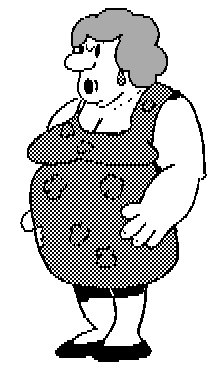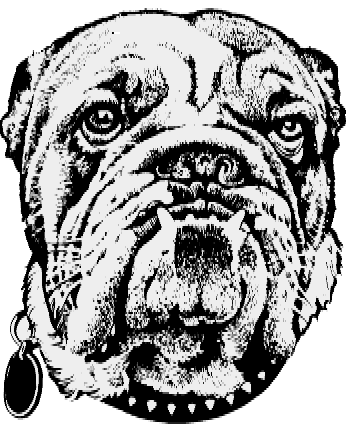
| 
|
ReggieMrs Fotherington-Smyth |
It is amazing how easy it can be to confuse people and animals. For medics there is usually no problem - unless your patient wanders in with a hamster stuck up his arse then you are unlikely to encounter animals in your surgery.
For vets, however, this confusion can present something of a problem. When Mrs Fotherington-Smyth and her poodle, Reggie, wander into your surgery it is imperative that only the poodle be treated. An attempt to neuter Mrs Fotherington-Smyth risks causing her annoyance, and worse, causing you confusion as you fail in your attempt to locate her testicles. Later parts of this lecture series will deal with sexual differences - but for now let's concentrate on attempting to differentiate Mrs Fotherington-Smyth and Reggie.

| 
|
ReggieMrs Fotherington-Smyth |
One important thing to note about Reggie is his legs. While his cannot be seen on the above photo, most of you will remember that dogs - in common with most domestic animals - have four legs. Mrs Fotherington-Smyth, on the other hand, has only two.
In fact, this leg method (as researched by prominent vet Dr J Holmes in his 1986 thesis) can be applied to many veterinary situations:
Dr J Holmes, 1986‘and so it can be seen that by simply treating the object in the room with the most legs, an 80% success rate can be achieved. Veterinarians wishing to use this method must be careful to learn the difference between live and dead otherwise an otherwise promising career can be wasted in attempting to treat chairs and examination tables.’
However, Dr Holmes' method came under heavy fire after a vet called in to Chester Zoo to artificially inseminate a bear with a broken leg caused ‘grave distress amongst several female members of zoo staff’. Further incidents, such as the permanent staining of an antique Chippendale table by £500 of racehorse semen, were not far off and this method is no longer advised.
The majority of animals a vet might be expected to treat during his or her practice cannot talk. A great number of these cannot even understand English beyond a few words such as ‘sit’ and ‘bad dog’. While a medic can expect their patient to understand a good explanation of, say, pronation of the forearm; it is an exercise in pointlessness for a vet to attempt the same. A vet can therefore use this to find out the identities of things in his room. Simply stand at such a point in the room that all the live things you do not recognise are in the same direction relative to you. Now aim your face in this general direction and attempt to hold a meaningful conversation. Anything that replies in English is probably human. Growling noises, mooing, neighing and other noises found on ‘Sesame Street’ should not be taken as a conversation, simply as an indication that the animal is alive.
This method causes confusion in only a few cases. Deaf or dumb owners, or a talkative parrot, can upset even the most experienced of vets and result in misapplied treatment. But don't worry! Even the very greatest veterinarians don't expect a 100% cure rate.
Humans have been blessed with the miracle of opposable thumbs. Most cows, dogs and horses have not. While a cry of ‘please oppose your thumb’ is likely to cause as much confusion to the owner as the vet, it is still possible to make use of this fact in animal identification.
Your surgery should be equipped with at least one rubber ball. This should be approximately the same size as an apple, but bouncy and less fruity. If you are unable to work out whether or not what you have is a rubber ball simply ask in your local toyshop. It is better to look slightly silly in the toyshop than risk being sold a hand grenade or other incendiary device.
Once you have this item in your surgery, it can be used for identification purposes. Simply go round the objects in your room one by one, throw them the ball and yell ‘Catch!’. A human, with opposable thumbs should have no difficulty in catching the ball, and maybe even returning it to you. Anything that shows no interest in the ball, or even moves away from it, is probably an animal - or could be dead. If you are not sure, repeat as many times as is necessary to clear your mind.
The only problem with this otherwise infallible method is the existence of dogs. These are cunning animals with a clear ball-catching instinct. The main difference you will see when a dog catches the ball instead of a person is the use of its mouth (see any good anatomy textbook) to contain the ball. If you are still unsure, examine the ball when it is returned to you. If the object was a dog it is likely that the ball will be liberally covered in slobber, half chewed and very sticky. Another strong hint is the fact that in all likelihood the object will now be in front of you wagging its tail and barking excitedly.
By now, you should be able to tell the difference between an animal and a person with a reasonable degree of accuracy. This will enable you to practise your art with acceptable losses. However, embryonic vets and medics must contend with one more possible source of confusion: paper. In your life, many letters and even exams will be in this form. It does not have any legs at all, cannot talk; and even though thumb-twiddling is a common occupation of those near it, it has no thumbs or fingers of its own. Yet medics and vets must be able to handle this substance without too much confusion.
In order to deal with paper it is important to be able to recognise the shapes of words. The following is a list of words which may help you. Those on the left will usually refer to animals. These are important for vets, and if they are seen in a letter or on an exam they probably indicate the question is a veterinary one. The words on the right are more commonly associated with humans.
| Words about animals | Words about people |
|---|---|
| VETERINARIAN | DOCTOR |
| VET | MEDIC |
| ANIMAL | PERSON |
| DOG | LADY |
| PIG | MAN |
| COW | OLD LADY |
| GOAT | OLD MAN |
| FOX | YOUNG LADY |
| STALLION | YOUNG MAN |
| ‘Tiddles is off his food’ | ‘The brat won't eat’ |
| ‘Rex is humpin' everything in the damn street’ | ‘Roger seems... rather more attentive than usual’ |
| ‘Provide a simple labelled sketch of the attachments of the lateral ligament of the ankle’ | ‘Provide a simple labelled sketch of the stomach of a sheep’ |